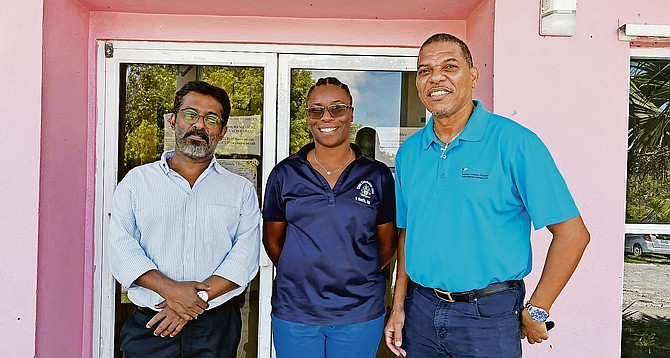The Warrens business district in Barbados was awash with a vibrant pink hue on Sunday as an estimated 20,000 participants gathered for the 2025 CIBC Walk for the Cure. This event marked one of the largest turnouts in its history, showcasing a profound display of unity and commitment to breast cancer awareness. Kemar Polius, Head of CIBC Barbados, expressed his awe at the scene, describing it as “a sight to behold.” He shared his experiences from similar walks in the Cayman Islands and the Bahamas, emphasizing that the Barbadian event was unparalleled in its scale and impact. Polius highlighted that the CIBC Caribbean has raised over US$5 million regionally, with more than BDS$1 million contributed in Barbados, to support cancer-fighting initiatives through the Breast Screening Programme of the Barbados Cancer Society. President Dame Sandra Mason, in her final public appearance before her term ends on November 29, officially opened the event and participated in the walk. Dr. Shirley Hanoman-Jhagroo, Medical Coordinator of the Breast Screening Programme, noted the significant progress Barbados has made in raising awareness and reducing the stigma associated with breast cancer. She emphasized the importance of early detection and revealed the introduction of a new $1 million mammogram machine that offers a more comfortable screening experience for both women and men. Dr. Hanoman-Jhagroo expressed gratitude for the widespread support from Corporate Barbados and the general public, underscoring the collective effort in advancing breast cancer awareness and treatment.
分类: health
-

BACSWN set to roll out new aviation emergency-response network across Bahamas
Executives from the Bahamas Aviation, Climate & Severe Weather Network (BACSWN) recently conducted a site visit to Long Island, engaging with health officials and residents while inspecting facilities at Stella Maris and Deadman’s Cay airports. This visit followed a series of town-hall meetings on Cat Island and virtual consultations with residents of Mayaguana, Inagua, Crooked Island, Acklins, and Long Cay. The initiative is part of a broader plan to establish a nationwide aviation emergency-response network, including aviation trauma centers, air-ambulance bases, and helicopter emergency medical services (HEMS).
Lyrone Burrows, a BACSWN executive, explained that the project stems from the group’s Heads of Agreement with the Bahamian government, which authorizes BACSWN to provide aviation meteorology services and live flight tracking. These services will form the foundation for a parallel emergency-response system designed to benefit both international aviators and local communities. Burrows emphasized the group’s commitment to creating trauma centers near every international airport, supported by ambulances, trained medical staff, and dedicated air-evacuation hubs. Four strategic locations across the southern, central, and northern Bahamas have already been identified for these bases.
The goal is to reduce emergency-response times to 30–40 minutes by positioning aircraft and personnel closer to high-risk areas. Burrows highlighted that this initiative will significantly improve access to life-saving interventions, with all activities being coordinated with relevant government ministries and agencies. BACSWN has partnered with Response Plus Medical (RPM), a global aviation emergency-services provider based in Abu Dhabi, to implement the project. RPM plans to deploy up to 50 aviation-based ambulances, over 200 medical professionals, and a HEMS network. Additionally, RPM will establish training centers in the Bahamas to prepare locals for new roles created by the project.
During their visit to Long Island, the BACSWN team met with Health Administrator Anya Forbes and toured the Simms Community Clinic with Head Nurse Stubbs. They also inspected both airports, where Bahamas Airports Authority executive Euley Glinton expressed strong support for the plan, noting its potential to enhance medical and firefighting capabilities for both aviation users and the broader community. Public meetings were held in Clarence Town and North Long Island High School, with Island Administrator Jandilee Archer delivering opening remarks.
Burrows encouraged residents to prepare for economic opportunities tied to the project’s rollout, including new jobs, real estate rentals, and support services. While BACSWN officials did not provide a specific start date for construction or deployment, they confirmed that the emergency-response network will be introduced in phases over the coming months, with government oversight and regulatory collaboration at each stage.
-

BACSWN set to roll out new aviation emergency-response network across Bahamas
Executives from the Bahamas Aviation, Climate & Severe Weather Network (BACSWN) recently conducted a site visit to Long Island, engaging with health officials and residents while inspecting facilities at Stella Maris and Deadman’s Cay airports. This visit followed a series of town-hall meetings on Cat Island and virtual consultations with residents of Mayaguana, Inagua, Crooked Island, Acklins, and Long Cay. The initiative is part of a broader plan to establish a nationwide aviation emergency-response network, including aviation trauma centers, air-ambulance bases, and helicopter emergency medical services (HEMS).
Lyrone Burrows, a BACSWN executive, explained that the project stems from the group’s Heads of Agreement with the Bahamian government, which authorizes BACSWN to provide aviation meteorology services and live flight tracking. These services will form the foundation for a parallel emergency-response system designed to benefit both international aviators and local communities. Burrows emphasized the group’s commitment to creating trauma centers near every international airport, supported by ambulances, trained medical staff, and dedicated air-evacuation hubs. Four strategic locations across the southern, central, and northern Bahamas have already been identified for these bases.
The goal is to reduce emergency-response times to 30–40 minutes by positioning aircraft and personnel closer to high-risk areas. Burrows highlighted that this initiative will significantly improve access to life-saving interventions, with all activities being coordinated with relevant government ministries and agencies. BACSWN has partnered with Response Plus Medical (RPM), a global aviation emergency-services provider based in Abu Dhabi, to implement the project. RPM plans to deploy up to 50 aviation-based ambulances, over 200 medical professionals, and a HEMS network. Additionally, RPM will establish training centers in the Bahamas to prepare locals for new roles created by the project.
During their visit to Long Island, the BACSWN team met with Health Administrator Anya Forbes and toured the Simms Community Clinic with Head Nurse Stubbs. They also inspected both airports, where Bahamas Airports Authority executive Euley Glinton expressed strong support for the plan, noting its potential to enhance medical and firefighting capabilities for both aviation users and the broader community. Public meetings were held in Clarence Town and North Long Island High School, with Island Administrator Jandilee Archer delivering opening remarks.
Burrows encouraged residents to prepare for economic opportunities tied to the project’s rollout, including new jobs, real estate rentals, and support services. While BACSWN officials did not provide a specific start date for construction or deployment, they confirmed that the emergency-response network will be introduced in phases over the coming months, with government oversight and regulatory collaboration at each stage.
-

Study finds women have higher genetic risk of depression
A landmark study conducted by Australian researchers has uncovered significant genetic differences in the risk of clinical depression between men and women. Published in the prestigious journal Nature Communications, the research analyzed the DNA of nearly 200,000 individuals with depression, marking it as one of the largest studies of its kind. The findings revealed that women possess nearly twice as many genetic markers associated with depression compared to men. Led by the Berghofer Medical Research Institute, the study identified approximately 13,000 genetic markers linked to depression in women, versus 7,000 in men. These genetic variations could influence biological pathways related to metabolism and hormone production, potentially explaining why women with depression often experience symptoms like weight fluctuations and altered energy levels. Researcher Jodi Thomas emphasized that understanding these genetic differences could pave the way for more personalized and effective treatments. The study also highlighted a historical bias in medical research, with most depression medications and studies predominantly focused on male participants. Clinical depression, affecting over 300 million people globally according to the World Health Organization, remains one of the most prevalent mental health disorders. This groundbreaking research offers new insights into the biological underpinnings of depression and underscores the need for gender-specific approaches in mental health treatment.
-

Mental health crisis
As global statistics reveal that a significant portion of the population will face mental health challenges at some point in their lives, Jamaican health officials are advocating for a comprehensive, society-wide strategy to tackle this pressing issue. In preparation for World Mental Health Day on October 10, 2025, Health and Wellness Minister Dr. Christopher Tufton emphasized the widespread nature of mental health concerns in Jamaica, citing a local study that found 40% of Jamaicans experience mental health issues during their lifetime. These include conditions such as depression, anxiety disorders, and schizophrenia. Dr. Tufton highlighted that mental health has emerged as a leading non-communicable disease in the country, necessitating collective action across all sectors of society. He stressed that addressing mental health is not the sole responsibility of the Ministry of Health but requires involvement from communities, schools, faith-based organizations, and the private sector. Supporting this call, Nurse Carol Baker-Burke, the Ministry’s Community Mental Health Coordinator, underscored the need for a unified approach to improve mental health outcomes nationwide. Dr. Kevin Goulbourne, Director of Mental Health and Substance Abuse, emphasized that individuals with mental health conditions can achieve recovery and lead productive lives with proper treatment. Consultant psychiatrist Dr. Kristen Robinson-Barrett urged Jamaicans to seek support early, starting at the community level, to prevent crises. Meanwhile, the Urban Development Corporation (UDC) encouraged Jamaicans to prioritize mental and physical well-being by engaging in activities such as healthy eating, exercise, and spending time in nature. UDC General Manager Bobby Honeyghan highlighted the importance of public spaces like Harmony Beach Park and Dunn’s River Falls in promoting relaxation and resilience. The government’s commitment to creating recreational spaces, such as the upcoming Portmore Resilience Park, reflects its dedication to fostering health and healing across the island.
-

OP-ED: Big Tobacco calls it harm reduction, Caribbean youth calls it profiting from addiction
The Caribbean has become a focal point for lobbying efforts by groups such as the World Vapers’ Alliance, Smoke Free Sweden, and We Are Innovation, as the region is strategically targeted to weaken tobacco control measures ahead of the 11th Conference of the Parties (COP11) to the World Health Organization Framework Convention on Tobacco Control (WHO FCTC). These campaigns, supported by tobacco and related industries, promote electronic cigarettes, nicotine pouches, and heated tobacco products as ‘harm reduction’ tools, despite evidence highlighting their risks, particularly for youth. Recent articles and social media campaigns in Barbados and Trinidad have attempted to frame these products as safe, ignoring their addictive nature and uncertain long-term health impacts. Nicotine, a key component of these products, is highly addictive and linked to cardiovascular disease, cancers, and impaired brain development in adolescents. The World Health Organization (WHO) has warned that the tobacco industry is using these products to undermine public health policies while aggressively marketing them to children and non-smokers. Dr. Arthur Phillips, Deputy Chief Medical Officer in Barbados, emphasized the vulnerability of Small Island Developing States to the long-term costs of tobacco and nicotine addiction. The Barbados National NCD Commission has also highlighted the rise of vaping as a serious threat, particularly to youth, who are targeted with sweet flavors and bright packaging. Caribbean governments, as parties to the WHO FCTC, must resist industry interference and defend evidence-based tobacco control policies. Mrs. Barbara McGaw of the Heart Foundation of Jamaica urged governments to act urgently, applying WHO’s MPOWER package to counter the spread of electronic nicotine delivery systems. Youth e-cigarette use in the region is alarming, with rates as high as 17.2% in Trinidad and Tobago. Dr. Asante LeBlanc of the Trinidad and Tobago Cancer Society emphasized the importance of campaigns like ‘Clear the Air’ to protect youth from nicotine addiction. As a youth tobacco control advocate, Dorial Quintyne, MPH, called for Caribbean governments to unite at COP11, reject industry interference, and champion effective tobacco control measures.
-

China creates ‘bone glue’ that will mend breaks in minutes
Chinese researchers have unveiled a groundbreaking innovation in medical science—a ‘bone glue’ capable of mending fractures in as little as three minutes. This revolutionary product, named Bone-02, promises to transform the treatment of bone injuries, which affect millions globally each year. According to a Lancet study, approximately 178 million fractures occur annually worldwide, with 18.3 million cases reported in the United States alone. Traditional fracture treatments often involve invasive procedures, such as the use of plates, rods, and screws, which can require additional surgeries for removal, prolonging patient discomfort and recovery time. Bone-02, inspired by the adhesive properties of oysters, offers a non-invasive alternative. It is injected directly into the fracture site, bonding bone fragments swiftly and effectively. The glue is particularly beneficial for treating smaller or awkwardly located fractures, where traditional methods may be unsuitable. Additionally, it minimizes the risk of infection and rejection, addressing significant challenges in fracture management. This innovation marks a significant leap forward in medical technology, potentially rendering complex treatments obsolete and improving patient outcomes globally.
-

Warning: Certain ingredients can cause death
For many, consuming even a small amount of certain foods can lead to a life-threatening condition known as anaphylactic shock. Common allergens like peanuts, shellfish, milk, and eggs are widely recognized, but the Grenada Food and Nutrition Council (GFNC) is raising awareness about lesser-known triggers that can be equally dangerous. These include lentils, sesame seeds, avocados, and even specific types of oils. Anaphylactic shock, a severe immune system overreaction, can rapidly constrict airways, cause swelling, and lead to a drop in blood pressure, dizziness, or loss of consciousness, potentially resulting in death. The GFNC emphasizes the importance of understanding and declaring all ingredients, especially when preparing food for others. They urge hosts and food vendors to ask about allergies, avoid including allergens in meals, and provide complete ingredient lists to ensure consumer safety. Ignoring these precautions can have fatal consequences. The GFNC also encourages the public to learn more about food allergies and nutrition through their resources and counseling services. Visit their website or social media for further information and support.


